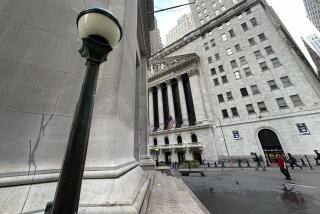Can the World’s Hottest Market Keep Climbing?
- Share via
MEXICO CITY — Just watching the futuristic trading floor of the Mexican Stock Exchange, it’s hard to imagine that this is the world’s hottest market.
Instead of traders in brightly colored smocks waving their arms frantically, men in tailored suits gather around rows of computer monitors, conversing and occasionally completing an order slip to seal a deal. Much of the trading is done directly between brokerages and registered by computer.
Yet, beneath the veneer of a gentlemen’s club is a free-wheeling market that has soared 57% in dollar terms since Jan. 1, while the average increase for world markets was 10%, according to Morgan Stanley Capital Investments.
The rise was so steep that the Bolsa, or purse, as Mexicans call the exchange, began the week by lopping three zeroes off its 39-stock index. After rising 600% in three years, it passed the 1 million mark last week, to become an unwieldy seven digits long.
Earlier this year, trading was extended an hour because of increased activity. Daily trading volumes have recently run at 80 million shares, less than half the daily volume on the New York Stock Exchange but huge for a market that averaged 20 million shares a day last year.
Today, as the Bolsa finishes a 13th straight week of gains, analysts are beginning to debate when the profit taking will start. Foreign money managers not already in the Mexican market are saying they missed the boat and are looking ahead to the next developing-country bull market.
But those in the Bolsa now argue that the rising prices are based on strong fundamentals that will make the best-run Mexican corporations growth stocks for the next three to five years.
The Bolsa’s run-up has been fueled largely by an influx of money from foreign institutional investors and a return of a modest part of the millions in flight capital that wealthy Mexicans moved across the border nearly a decade ago. The other big factor has been the soaring price of Telefonos de Mexico (Telmex), the telephone company that accounts for nearly a third of the entire market.
Such dominance by a single issue is typical of the stock exchanges of developing countries. “That’s why they shoot up like rockets and fall back like stones,” said Jay Pelosky, a portfolio manager and emerging markets specialist at Morgan Stanley.
Indeed, this is not the first bull let loose on the Bolsa. The Mexican market enjoyed dramatic run-ups--and suffered equally dramatic crashes--in 1979 and 1987.
The question is whether the current boom will end in ignominy or with the emergence of the Bolsa as a world-class stock exchange.
The debate starts with Telmex, the stock that led the upswing.
Telmex has been rising since the Mexican government announced plans to sell its 56% stake in the company as part of its eight-year-long privatization drive.
The price increases are justified by the restructuring of the regulatory environment for the telephone company, said a money manager with a significant position in the stock. Analysts generally expect earnings to rise, which will keep the price heading upward.
A continuing rise in Telmex virtually assures that the index will keep climbing but does not necessarily mean success for the other 290 stocks on the exchange.
Telmex has carried the rest of the market up with it partly because of regulatory changes that have opened all the issues on the market to foreign investors indirectly through a trust administered by Nafinsa, a government-owned development bank. Previously, foreign investors were restricted to a small number of issues that they could own directly.
In all, foreign investment in the Bolsa totals $2.4 billion, not counting investments in mutual funds. That may seem small in a market with a total capitalization of $65 billion, but foreign money has a big impact on prices because most of the registered shares seldom change hands. Less than one-tenth of the listed stocks are considered actively traded by the Bolsa’s own standards, and trading volume rarely reaches $100 million a day.
“About half the free float in the market is held by foreigners,” said Pelosky, who has not invested in the Mexican market.
He is concerned about the boom’s dependence on foreign investment, money that roams the world looking for the best opportunities and that could easily abandon Mexico next week for Southeast Asia or South America. “What is going to be there to hold the market up after that?” he asked.
Another investment manager, who has a significant portion of the emerging-markets part of his portfolio invested in the Bolsa, scoffs at that reasoning.
“There is this idea that domestic money is stable and foreign money is not,” he said. “We saw in 1987 that the domestic guys will take their money out faster than anyone else. Institutions tend to have a longer time horizon.”
However, he added, Mexican companies must perform--expand production, improve productivity and increase profits--to keep foreign investors interested. “If Mexico is no longer an attractive growth area, you’ll see that money leave,” he said.
“The Mexican market has a bright future, but it has also had quite a run,” Pelosky said. “The market has gone up 600% in three years.
Mexican Stocks: A Hot Market, Getting Hotter.
The 39-stock Bolsa index of the Mexican Stock Exchange has risen exponentially since 1985--though the volatility along the way has been hair-raising for investors. YEAR-END 1985: 11.20 ‘86: 47.10 ‘87: 105.67 ‘88: 211.53 ‘89: 418.93 ‘90: 628.79 So far this year, the Bolsa has rocketed more than 60%: MONTH-END 1990 Dec.: 628.79 1991 Jan.: 622.99
Feb.: 659.17
March: 803.36
April: 901.14
May 17: 1017.94
More to Read
Inside the business of entertainment
The Wide Shot brings you news, analysis and insights on everything from streaming wars to production — and what it all means for the future.
You may occasionally receive promotional content from the Los Angeles Times.










